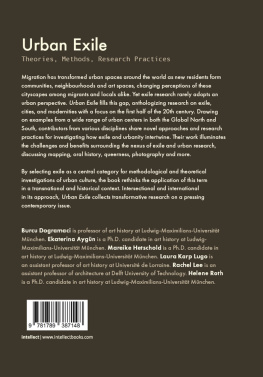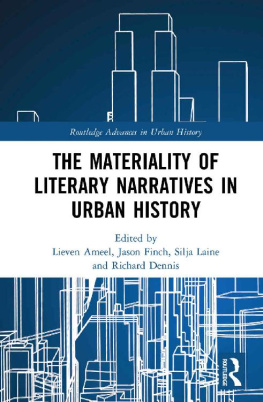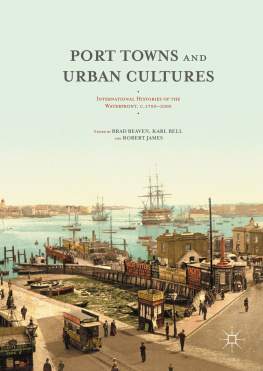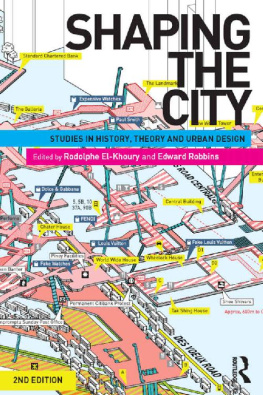Testimonies of the City
Historical Urban Studies
Series editors: Richard Rodger and Jean-Luc Pinol
Titles in this series include:
Culture and Class in English Public Museums, 18501914
Kate Hill
European Cities, Youth and the Public Sphere in the Twentieth Century
Edited by Axel Schildt and Detlef Siegfried
City Status in the British Isles, 18302002
John Beckett
Resources of the City Contributions to an Environmental History of Modern Europe
Edited by Dieter Schott, Bill Luckin and Genevive Massard-Guilbaud
The European City and Green Space London, Stockholm, Helsinki and St Petersburg, 18502000
Edited by Peter Clark
Property, Tenancy and Urban Growth in Stockholm and Berlin, 18601920
Hkan Forsell
Civil Society, Associations and Urban Places Class, Nation and Culture in Nineteenth-Century Europe
Edited by Graeme Morton, Boudien de Vries and R.J. Morris
The Transformation of Urban Liberalism Party Politics and Urban Governance in Late Nineteenth-Century England
James R. Moore
Paris-Edinburgh Cultural Connections in the
Belle Epoque Sin Reynolds
The City and the Senses Urban Culture Since 1500
Edited by Alexander Cowan and Jill Steward
Testimonies of the City
Identity, Community and Change in a Contemporary Urban World
Edited by
Richard Rodger
and
Joanna Herbert
First published 2007 by Ashgate Publishing
Published 2016 by Routledge
2 Park Squre, Milton Park, Abingdon, Oxon OX14 4RN
711 Third Avenue, New York, NY 10017, USA
Routledge is an imprint of the Taylor & Francis Group, an informa business
Copyright Richard Rodger and Joanna Herbert, 2007
Richard Rodger and Joanna Herbert have asserted their moral rights under the Copyright, Designs and Patents Act, 1988, to be identified as the editors of this work.
All rights reserved. No part of this book may be reprinted or reproduced or utilised in any form or by any electronic, mechanical, or other means, now known or hereafter invented, including photocopying and recording, or in any information storage or retrieval system, without permission in writing from the publishers.
Notice:
Product or corporate names may be trademarks or registered trademarks, and are used only for identification and explanation without intent to infringe.
British Library Cataloguing in Publication Data
Testimonies of the city: identity, community and change in a contemporary urban world. (Historical urban studies)
1.Sociology, Urban
I. Rodger, Richard II. Herbert, Joanna
307.7'6
ISBN: 978-07546-5560-2
Library of Congress Cataloging-in-Publication Data
Testimonies of the city: identity, community, and change in a contemporary urban world / edited by Richard Rodger and Joanna Herbert.
p. cm. (Historical urban studies series)
Includes bibliographical references and index.
ISBN: 978-0-7546-5560-2 (alk. paper)
1. Cities and towns Europe History 20th century. 2. Social change Europe History 20th century. 3. Sociology, Urban Europe. 4. Oral history Europe. 5. Europe Social conditions 20th century. 6. Social history 20th century. I. Rodger, Richard. II. Herbert, Joanna. III. Series: Historical urban studies.
HT131.T474 2007
307.7609409'04 dc22
2006017123
ISBN: 9780754655602 (hbk)
Contents
Joanna Herbert and Richard Rodger
Ronnie Johnston and Arthur McIvor
Eszter Zsfia Tth
Sndor Horvth
Valentina Gulin Zrni
Leen Beyers
Caroline Varlet
Maria Raluca Popa
Vernica Sales Pereira
Ruth Wallach
Wladimir Fischer
Joanna Herbert
Historical Urban Studies General Editors Preface
Density and proximity are two of the defining characteristics of the urban dimension. It is these that identify a place as uniquely urban, although the threshold for such pressure points varies from place to place. What is considered an important cluster in one context may not be considered as urban elsewhere. A third defining characteristic is functionality the commercial or strategic position of a town or city that conveys an advantage over other places. Over time, these functional advantages may diminish, or the balance of advantage may change within a hierarchy of towns. To understand how the relative importance of towns shifts over time and space is to grasp a set of relationships that is fundamental to the study of urban history.
Towns and cities are products of history, yet they themselves have helped to shape history. As the proportion of urban dwellers has increased, so the urban dimension has proved a legitimate unit of analysis through which to understand the spectrum of human experience and to explore the cumulative memory of past generations. Though obscured by layers of economic, social and political change, the study of the urban milieu provides insights into the functioning of human relationships and, if urban historians themselves are not directly concerned with current policy studies, few contemporary concerns can be understood without reference to the historical development of towns and cities.
This longer historical perspective is essential to an understanding of social processes. Crime, housing conditions and property values, health and education, discrimination and deviance, and the formulation of regulations and social policies to deal with them were, and remain, among the perennial preoccupations of towns and cities no historical period has a monopoly of these concerns. They recur in successive generations, albeit in varying mixtures and strengths; the details may differ.
The central forces of class, power and authority in the city remain. If this was the case for different periods, so it was for different geographical entities and cultures. Both scientific knowledge and technical information were available across Europe and showed little respect for frontiers. Yet despite common concerns and access to broadly similar knowledge, different solutions to urban problems were proposed and adopted by towns and cities in different parts of Europe. This comparative dimension informs urban historians as to which factors were systematic and which were of a purely local nature: general and particular forces can be distinguished.
These analytical and comparative frameworks inform this book. Indeed, thematic, comparative and analytical approaches to the historical study of towns and cities is the hallmark of the Historical Urban Studies series, which now extends to over 30 titles, either already published or currently in production. European urban historiography has been extended and enriched as a result and this book makes another important addition to an intellectual mission to which we, as General Editors, remain firmly committed.
Richard Rodger, University of Leicester










